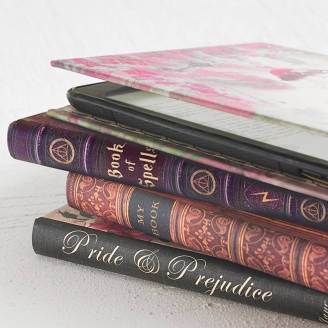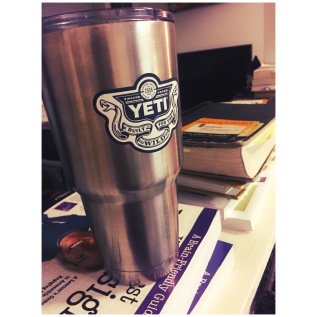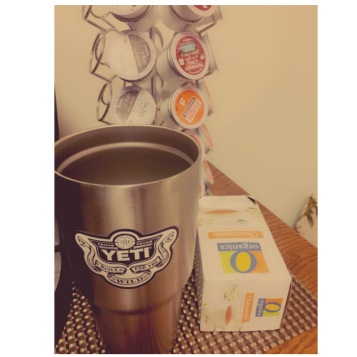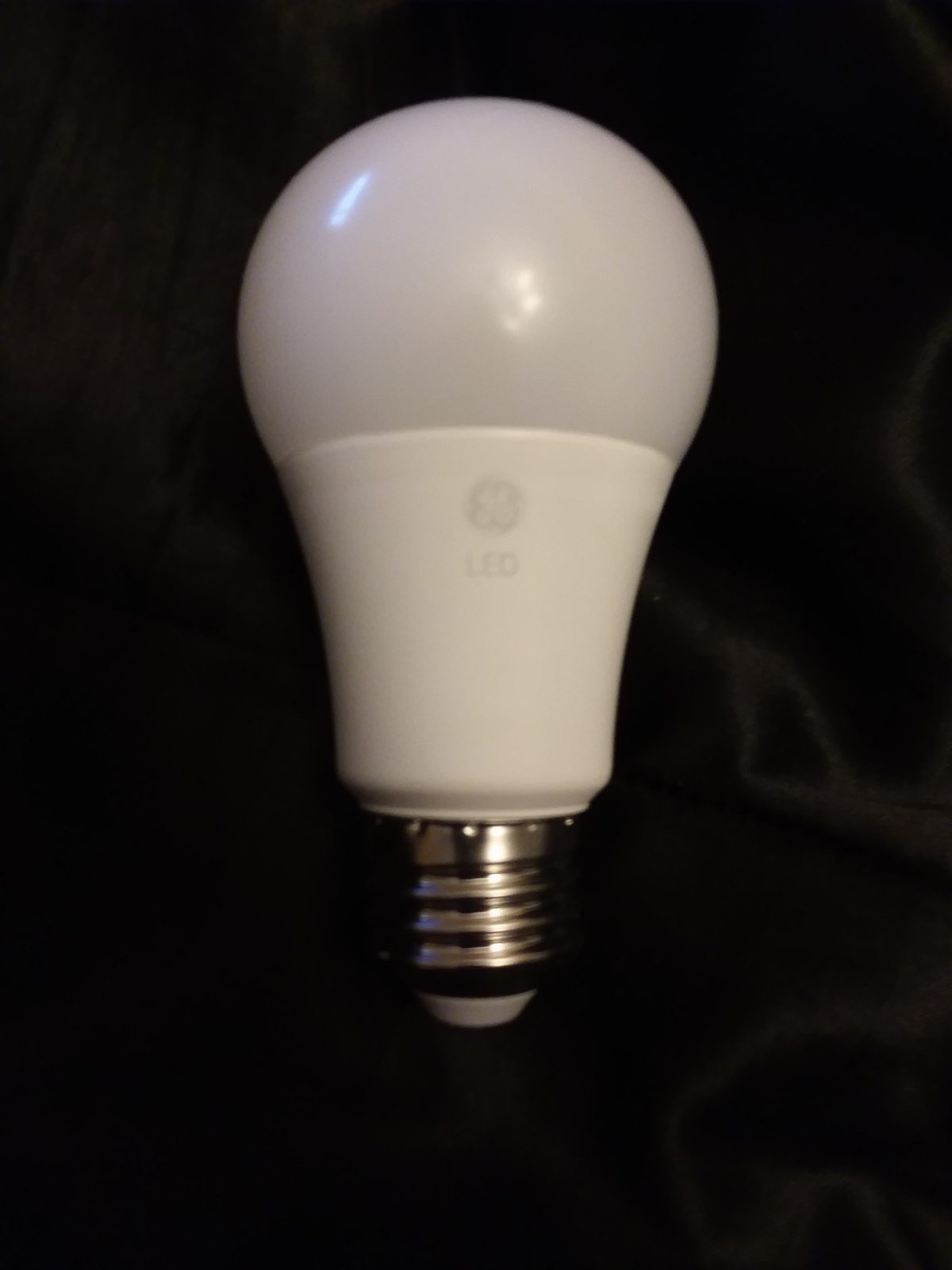I recommend this product!
COST
Best Prices
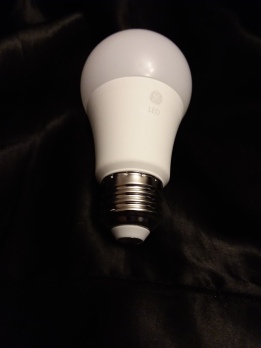
(Sold by multiple sellers online and in stores)
VITAL INFORMATION
PROS AND CONS
Pros:
Long-lasting LED saves money in long-run
Replaces 60 W incandescent with only 10 W
Dimmable, soft white light is sufficient
Energy Star certified
Mercury free
Cons:
More expensive up front
Not all bulbs are equally reliable and long-lasting
LED-specific dimming system required for dimmable features
WHY YOU SHOULD BUY THIS LED BULB
This product is likely for you if you respond ‘yes’ to the following:
- Tired of forfeiting your hard-earned money for basic lighting?
- Using wasteful, short-lasting light bulbs that black out before you know it?
- Are you new at trying to save money on energy-saving lighting?
If you answered yes two or more times, the solution is here, and likely to stay for a while. Save money. Use less energy. Get the same lighting power for less. I would recommend you live for the long-term with GE’s line of dimmable LED bulbs. It’s nothing fancy, it’s just savings for you and your family.
QUESTIONS FOR ENLIGHTENMENT
Q: How much money and energy do I save with LED?
A: This general purpose, 10-watt LED lightbulb from GE is the brightness-equivalent of 60 watts traditional/incandescent and saves energy over halogen and CFL bulbs too. Lasts 13.7 years and costs $1.20 in energy based on 3 hours/day usage. Yes, you spend a bit more money up front, but the savings in the long-term are impeccable.
Q: But it’s so cheap! And so readily available. Is it worth it—what’s the catch?
A: It is not luxury, but it will do the job. It has a traditional shape, but with a sleek, classy LED look. Gives off abundant, soft white light emitting from the upper portion of the bulb. Powers up to 800 lumens, so it’s powerful enough. Fits general slots for traditional 60 W bulbs. That means all you must do is twist into your favorite fixture, and the bulb is up and running, saving you energy and money.
Q: Can you dim LED bulbs?
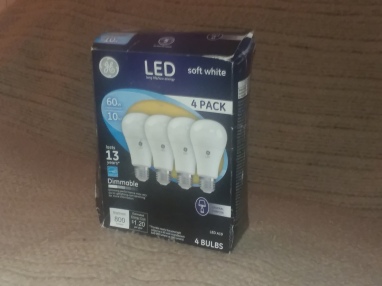
A: This LED bulb is compatible with LED dimming systems, giving you the power to adjust the amount of light in your room.
But, as I learned from experience and research, old dimming fixtures and systems will not work with these lights—at least not correctly. Get an LED dimming system.
Q: Why not buy another bulb, like CFL, Halogen, or Incandescent?
A: Incandescent are going out of existence. They were wasteful and short-lasting. Forget them.
Halogen bulbs are slightly better versions of incandescent. They are cheap and available, but they don’t save as much energy and don’t last as long as CFL or LED.
The real battle is between CFL and LED, and they have generally equal power, lifespan, and cost. I would heavily recommend against CFL bulbs because they contain mercury and must be the most carefully recycled. If you do buy CFL, please visit your local government’s website on how to properly recycle.
LED is safe. It is consistent. And its bulbs are sometimes offered at subsidized lower costs, thanks to the energy company and/or government. See your local listings if you buy in store.
For more information, please visit the Toms Guide article on this subject.
Q: What do you know? Have you even used these light bulbs?
A: Yes, in multiple locations in my house, but especially in my dining room chandelier with five light positions. I have had nothing but good experience. I have ample light with only three lights currently placed in the chandelier (five bulbs of any kind are overwhelming for a medium-size room on a daily basis). The bulbs have definitely lasted longer than my previous halogens and incandescent bulbs.
I do not have a dimming system for LED yet. I used to believe LED lights were not compatible with dimming. But hey—I was wrong. And I plan on getting an LED-compatible dimming system, so stay tuned for the update!
THE DARK SIDE
You will spend more up front, and there is the possibility not all bulbs will last equally as long and be equally as reliable. The Target reviews make this surprisingly evident—contradicting the grandiose claims corporate America makes about LED bulbs. But this is somewhat made up for with the bulb’s warranty. Going through the warranty process can be cumbersome, however. These potential negative aspects will, on average, be negated by the positive aspects of the lightbulb.
Please only dim these bulbs under a dimmable system and fixture.
There are surprisingly negative reviews at Target based on inconsistency of bulbs. I would not let this anomaly deter my purchasing decision.
SPECS
Wattage: 10
Equivalent of: 60 W Incandescent
Voltage compatibility: 120 V
Shape: Pear, A19
Temperature: 2700 Kelvin
Base Size: Standard Edison, medium screw base E26
Quantity: 4-pack GE at most sellers, 1-pack at True Value
Limited Warranty: Guaranteed to last 5 years based on rated life at 3 hours use per day at 120 V. Other legal rights available to customer based on location. Use only in dry locations and with correct voltage.
- Energy Star Certified.
- UL-Listed for safety.
- Mercury free.
Imported from China.
SIMILAR LED BULBS
About $4
(Similar but not dimmable, I would not recommend)
About $9
(More powerful light, not dimmable, I would recommend only if you are not interested in dimming)
$16.99
(I would recommend this only for small spaces as advertised, and it has good reviews)
$3.95
(I would recommend based on low price and good reviews).
$4.99
(Waste of money just buying 1, I would not recommend)
EVOLUTION OF THE LIGHT BULB

- Thomas Edison commercialized the incandescent bulb in 1880.
- Both Edison and Nikola Tesla experimented with fluorescent technology in late 19th century
- Energy Shortages led to experimentation with fluorescent light bulbs and invention of CFL in 1970s by GE’s Edward Hammer
- CFLs increased in abundance in 1980s, as both CFL and LED were more efficient than incandescent in giving off lumens per watt.
- LEDs began to spread publicly (traffic lights, TVs, flashlights) and became the most efficient light bulb by the 2000s.
- LED prices have fallen steeply since 2008.
Source: energy.gov

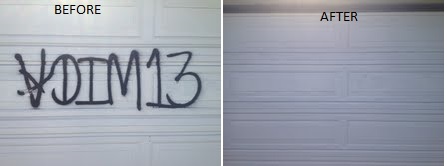


 As a self-proclaimed bookworm, I adore the smell, look, and feel of books, bookstores, and libraries. My personal library is constantly growing, and I’ll never truly have enough. With that said, however, I too have jumped on the e-reader bandwagon. In particular, I bought a
As a self-proclaimed bookworm, I adore the smell, look, and feel of books, bookstores, and libraries. My personal library is constantly growing, and I’ll never truly have enough. With that said, however, I too have jumped on the e-reader bandwagon. In particular, I bought a 